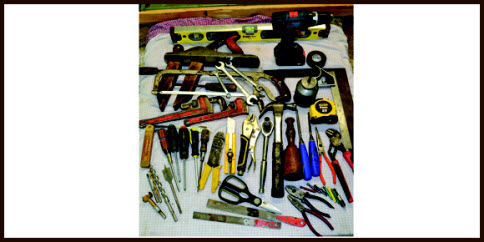For me, one of life’s great mysteries is why homeowners possess plastic boxes containing dollar store tools and notions?
I suspect part of the answer is that toolboxes, no matter what’s inside, including chewing gum and thread, make non-DIYers feel safe about handling their own household emergencies.
Let’s say, for example, a shut off valve begins to leak under a sink — no reason to panic. Break open the toolbox, plug the hole with gum and secure the patch by lashing thread around it several hundred times. Situation under control. No need to immediately call a plumber, if ever.
When I visit friends, relatives or acquaintances who know I am a DIYer, they often ask me “to take a quick look” at a problem such as a small drip issuing from a water pipe. I’m flattered because when it comes to fixing something, I’m like a northern pike in pursuit of a Red Devil lure — I can’t resist.
Recently, a friend invited me to peek inside a kitchen cabinet from which a “wee bit of water had been leaking onto the floor.” The soaked towels shoved under the kickplate told a different story, but I was intrigued and happy to indulge him, even though he drinks lite beer.
I opened the cabinet’s door. Inside, a Scottish mist was issuing from a shut-off valve that had been repaired with chewing gum and multiple twists of black thread.
“Well,” I said, removing my wet face from the interior of the cabinet, “You have some seepage from a shut-off valve. Do you have a toolbox?”
Why did I ask that dumb question? From experience with other non-DIY friends, I could divine the contents of his toolkit: a multi-purpose screwdriver with a broken handle, cheap metal bits from the screwdriver, a sink plug, a rusty rasp, a seamstress’s tape measure, an empty roll of electrician’s tape and, of course, a spool of thread and a pack of gum. There’s no need to continue.
I don’t want to sound smug, but if you are not a DIYer, why do you insist on wasting money on cheap and inappropriate tools? If you want to feel safe, a fire extinguisher and a smoke/radon detector are much better investments.
To get to the point, I would like to suggest some of the essential tools every DIYer (or household wannabe DIYer) should own to properly fix broken stuff.
It is implied that the following tools should not be purchased at a five and dime store; meaning, buy precise, expensive items that can be passed on to your grandchildren:
• Vise-grips, WD-40 and roll of duct tape. (The Walt Kowalski Toolbox.)
• Adjustable hacksaw, accepts variety of blade lengths.
• At least two pipe wrenches and several crescent wrenches.
• Hand saws: back, rip and crosscut.
• Selection of hammers, including rubber and wood mallets.
• Jack plane.
• Levels: two-foot and eight-foot.
• Carpenter’s square, adjustable square, bevel.
• Box cutter, one-inch replaceable blades.
• Drill bits including auger, Forstner, brad point, spade and jobber.
• Screwdrivers, all sizes of Robertson, Phillips and flat blades.
• Selection of screw bits and quick-change adaptor for power drilling deck screws, etc.
• Minimum 18-volt cordless drill, jig saw and skill saw.
• Carpenter’s chisels, rasps, files, sharpening stones.
• Wood clamps.
• Portable saw horses.
• Heavy duty extension cord with multiple-outlet female head.
• Trouble light, flash light with fresh batteries.
• Wire cutters, strippers and sheathing remover.
• Soldering iron, paste and solder.
• Portable electric chop saw.
• Palm, orbital sander, several grits of paper.
• Angle grinder for cutting steel, stone and rapidly removing wood.
Combined with the Walt Kowalski Toolbox, I believe the above list of tools should be sufficient to allow a DIYer to tackle and overcome most household problems. Other items like chalk lines, cabinet scrapers, spoke shaves and carving tools can be added as required.
I would appreciate suggestions from DIYers who feel I have missed an essential item or own a tool they believe should be added to the basic box, email to davidsquare@yahoo.com



